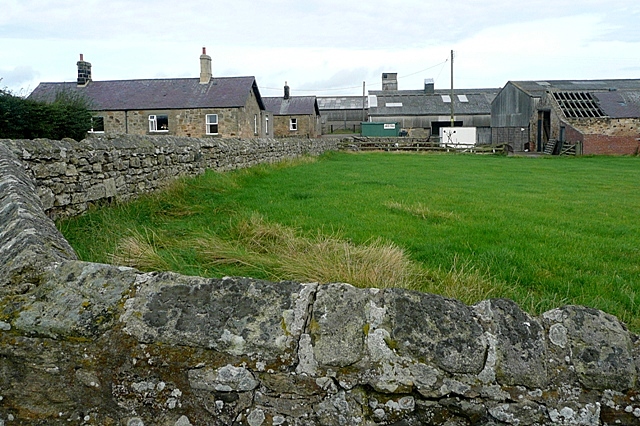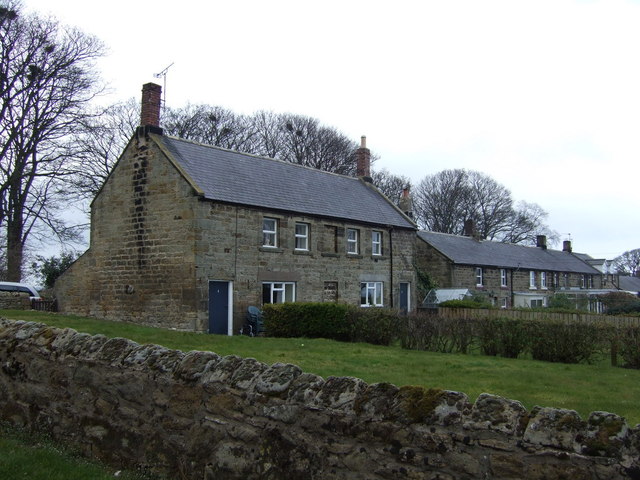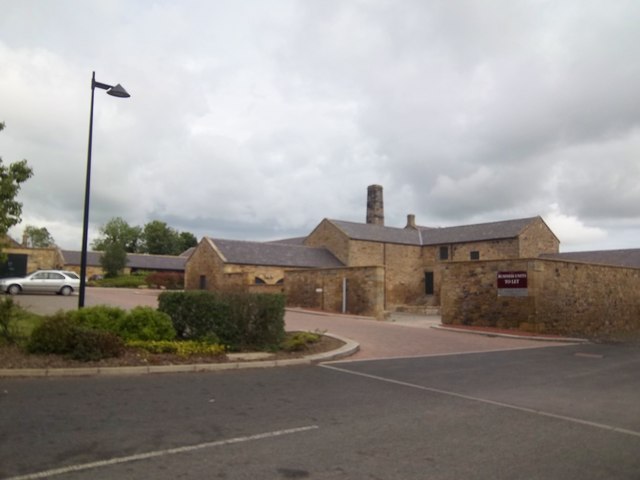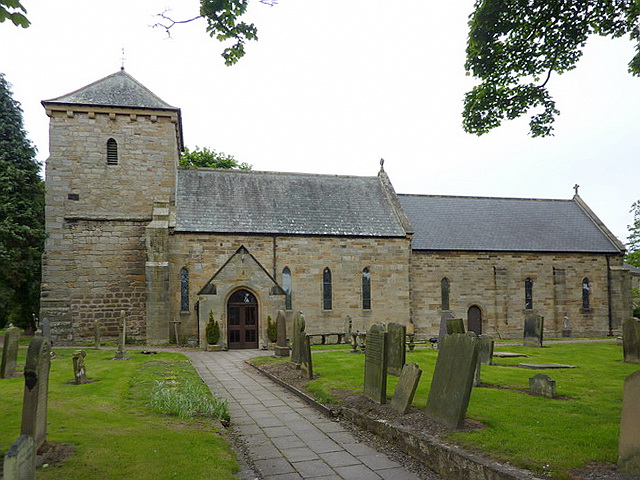Topics > Northumberland > Civil Parishes in Northumberland > Lesbury Civil Parish > Lesbury Parish, 1855
Lesbury Parish, 1855
Extract from: History, Topography, and Directory of Northumberland...Whellan, William, & Co, 1855.
LESBURY PARISH
LESBURY is a parish comprising the townships of Alnmouth, Bilton, and Lesbury, and is bounded on the north by Long Houghton, on the west by Alnwick, on the south by High Buston and Shilbottle, and on the east by the German Ocean. It captains 2,624 acres, and the number of its inhabitants in 1801, was 874; in 1811, 858; in 1821, 982; in 1831, 976; in 1841, 1,108; and in 1851, it had increased to 1,238 souls. A portion of this parish extends across the river Aln into Coquetdale Ward.
ALNMOUTH, or, as it is often called, Alemouth, is a township and small port, the property of the Duke of Northumberland. The township comprises an area of 579 acres, and its rateable value is £1 ,340. Population in 1801, 350; in 1811, 353; in 1821, 406; in 1831, 415; in 1841, 480; and in 1851, 488 souls. THE VILLAGE and Port of Alnmouth is situated, as its name implies, at the mouth of the Aln. It occupies a high and airy situation, upon a promontory between the river and the sea, about five miles E.S.E. of Alnwick, and carries on a considerable trade in the exportation of corn, while large quantities of timber and merchandise are imported from Holland. The ruins of a chapel dedicated to St. John the Baptist stood upon an eminence near the sea, but it has been almost washed away by tidal action, and would have entirely disappeared had it not been protected by a wall erected by the Duke of Northumberland. Here is a Wesleyan Methodist chapel, erected by the late Mr. John Appleby, a corn merchant in the village. A school is held in the chapel, and twenty poor children receive a gratuitous education, Mr. Appleby having left £20 per annum for that purpose. William Burn, teacher.
POST OFFICE ALNMOUTH, Robert Simpson, Postmaster. Letters arrive, from Alnwick, at 11-45 a.m., and are despatched thereto at 3-15 p.m.
Directory
|
Armstrong James, tailor Brown Jane, vict. Ship Inn Blythe John, tailor Burn William, schoolmaster Charlton Mr. Thomas Crozier Christopher,· draper Dickinson Archibald, corn merchant and herring curer Edmondson Mrs. Mary Edmondson J ames Elliott, the Misses S. & A. lodging house Gibb Robert, master mariner Gowens William, vict. and stonemason, Red Lion Hunter Thomas, vict. Royal Oak, Alnmouth-road Heatley Henry, master mariner |
Marshall James, custom housa officer Robinson John, boot and shoemaker Robson Andrew, relieving officer, and registrar of births and deaths for the Warkworth district Simpson Edward, baker Simpson Mr. John Simpson John, tailor Simpson Joseph, grocer Simpson Robert, shipowner and agent Strother William, Esq. Thompson Rev. Moorhouse, M.A. curate Walby William, gardener Young John, harbour master Young William, boot and shoemaker |
BILTON is a township and hamlet in the above parish, situated on the south side of the Aln, in the east division of Coquetdale Ward. THE HAMLET of Bilton is pleasantly situated on the road leading from Alnwick to Warkworth, about three miles south-east by east of the latter place. Here is a station on the York, Newcastle, and Berwick railway, and for the Alnwick branch line. BILTON HOUSE, the residence of Thomas Tate, Esq., is finely situated on an eminence which commands many fine views of the surrounding country.
DIRECTORY. Thomas Tate, yeoman, and land agent and valuator to the Duke of Northumberland, Bilton House; William Pender, blacksmith; John Straughan, shopkeeper; and George Taylor, farmer, Bilton Barns.
LESBURY, a township and village, gives name to the parish in which it is situated. The area of the township, inclusive of the hamlets of Bilton, Hawk-hill, and Wooden, which are united with Lesbury for the relief of the poor, though distinct for every other purpose, is 2,054 acres, and its rateable value is £8,116 15s. 9d. The Duke of Northumberland is landowner. Population in 1801, 524; in 1811, 505; in 1821, 576; in 1831, 561; in 1841, 628; and in 1851, 750 souls.
THE VILLAGE of Lesbury is situated on the northern bank of the Aln, over which there is a neat stone bridge, three and a half miles east by south of Alnwick. THE CHURCH, dedicated to St. Mary, has been recently repaired and beautified. The living is a discharged vicarage in the archdeaconry of Lindisfarne and deanery of Alnwick, valued in the Liber Regis at £8 2s. 10d.; gross income, £282, and is in the patronage of the Crown. Rev. Moorhouse Thompson, curate. A new vicarage has been erected during the present year. Here is a National School, and an extensive corn-mill. In November, 1850, several cist-vaens, or stope coffins, were discovered on the summit of a hill, about a quarter of a mile from Lesbury, and near to the Newcastle and Berwick railway. This hill is one of the Boulder formation, which modify, in a peculiar planner, the physical features of the eastern part of Northumberland. It commands a fine view of Alnmouth Bay, and of the vale of the Aln, with the Cheviots in the background. Five cist-vaens were opened all differing from each other in size, and lying in different directions; they were however, constructed in a similar manner. The clay subsoil had been hollowed out to the depth of from two to four feet, and slabs of stone, generally four, were placed on edge against each other, so as to form a quadrangular space; these were covered with a larger slab, and above this, large stones were heaped up to the height of more than two feet. The structure was simple and rude enough. No cement had been used, no ornament or inscription appeared, the only indication of the use of a tool being a few marks on the covering slabs, similar to those made by a mason's pick. The slabs were regularly bedded grey sandstones, such as are found in situ on the neighbouring coast, and the stones piled up to form the artificial tumulus, or barrow, were the boulders of basalt, limestone, and sandstone, which occur abundantly in the boulder-clay deposit of the neighbourhood.
BIOGRAPHY. The Rev. Percival Stockdale, formerly vicar of this parish, was the only child of the Rev. Thomas Stockdale, vicar of Branxton. Having received a good education at Alnwick and Berwick, he, on the demise of his father, entered the army' as a lieutenant in the Q3rd regiment of foot, in which he served for some time. The regiment having received orders to embark for India, Lieutenant Stockdale resigned his commission, and two years afterwards received deacon's orders from Dr. Trevor, Bishop of Durham. He then went to London, where he spent his time in the society of Garrick, Dr. Johnson, Dr. Brown, and Goldsmith. He afterwards became curate to Mr. Thorpe, the vicar of Berwick, but in a short time gave up his curacy, and embarked for Italy, where he read and wrote very assiduously. On his return in 1769, be translated "Tasso's Aminta," and shortly afterwards succeeded Dr. Guthrie, as editor of the "Critical Review." In 1782 he took priest's orders, and in the following year was presented by Lord Chancellor Thurlow with the living of Lesbury, to which the Duke of Northumberland added that of Long Houghton. Here he wrote his tragedy of “Ximenes," but in consequence of his declining health, he accepted an invitation to Tangiers, where he passed some time. On his return he wrote an elaborate "History of Gibraltar," which he subsequently destroyed. He afterwards wrote some poems, and published his "Lectures on the Poets," and also his "Memoirs of Himself," dedicated to the celebrated Miss Porter. He died at Lesbury, on September 14th, 1811, aged 78 years.
CHARITIES. John Coulter, in 1742, left £20 to the poor of Lesbury, in respect of which £2 9s. 3d. was paid from a gallery erected in the church. The pews in this gallery are let, and the rents, amounting to £7 8s. 3d. per annum, are distributed by the minister and churchwardens at Christmas and Midsummer, in small sums among the poor of the parish.
HAWK HILL is a joint township with Lesbury, and is situated on the north bank of the Aln, about two and a half miles east by south of Alnwick. It is the property of Earl Grey, and consists of one farm in the occupancy of Mr. Thomas Chrisp.
WOODEN is a hamlet in this township, but locally situated in Coquetdale Ward, four and a half miles south-east by south of Alnwick. It is exclusively occupied and farmed by Mr. Roger Buston, of Buston Hall.
Directory
|
Anderson Elizabeth, shopkeeper Bayd William, shopkeeper Bell Edward. vict. and. blacksmith, Blacksmiths’ Arms Bell Robert, blacksmith Boyle Stephen, shoemaker Dawson Rev. Charles, vicar, Vicarage Dickson Joseph, joiner and cartwright Flintoff Walter, joiner and millwright Forster William, cartwright Moor Joseph, vict. Northumberland Arms Reyners Samuel A. schoolmaster & parish clerk Swan John, boot & shoemaker Tate George, stonemason Thompson William, clerk, Lesbury Mill |
Wilson Edward, shopkeeper Young Joseph, beer retailer
Farmers Buston Roger, Buston Hall Cairns Ralph, Link Farm Chrisp Thomas, Hawkhill Dand Robert, Esq., Field House Eadington James, & miller, Bilton Mill Egdell Thomas, Waterside Embleton Lucy, Foxton Hall Embleton Thomas, Town Head Gardner Robert, Waterside Farm Swan Mark, and overseer, Hill Head Wilson Charles, Hipsburn |
















